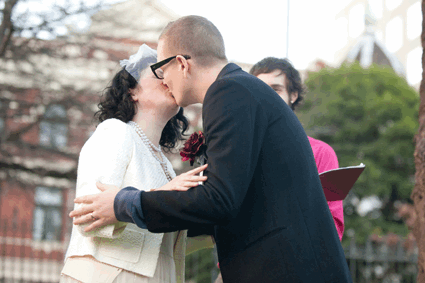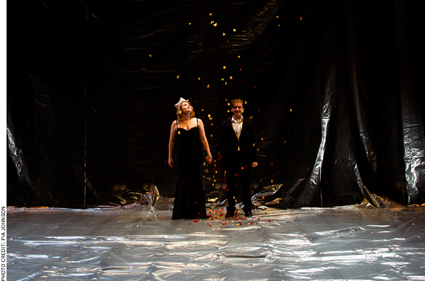Come & play
Robert Reid: Play In Australian Performance Practice

Tahni & Tom, Shotgun Wedding, NO SHOW, Next Wave Festival 2012
Photo Sarah Walker
Tahni & Tom, Shotgun Wedding, NO SHOW, Next Wave Festival 2012
In “The theatre of rehearsing for life” (RT115) playwright Robert Reid reported on a visit to the UK where he researched ‘New Games’ theatre in which audiences become active agents “within constructed narrative environments,” practising “‘ways of being’ in ‘not for real spaces.’” Here he looks at the work of two Melbourne companies who, to varying degrees, directly engage with their audience [Eds].
“I was giddy. It’s the only word for it. I held a manic grin on my face all afternoon. All of these people had come out to celebrate us! There was so much joy in the air, I was wearing a beautiful dress, my nails were freshly painted navy blue to match Naomi’s dress, my make-up was done. I was married! This was my wedding day!” Jane Howard, review, My Shotgun Wedding.
Critic Jane Howard is describing her experience of Melbourne-based company No Show’s work Shotgun Wedding, presented as part of the 2012 Next Wave Festival. Jane reviewed the work in the Real Time E-dition June 26, and, a year later, revisited her experience on her No Plain Jane blog. “I refer to that day, still, as ‘my wedding,’ or ‘the day I got married.’ I go back to Melbourne and am introduced to people who look vaguely familiar: ‘I was at your wedding!’ they tell me.”
Shotgun Wedding can be seen as one of an increasing number of performance works that interrogate, transgress and/or repurpose the relationship between the performer and the observer. Internationally this kind of participatory performance experience is represented by companies and collectives such as Punchdrunk, Coney and Slingshot and locally can be seen in the growth of Live Art and New Games.
With Shotgun Wedding, co-directors Bridget Balodis and Mark Pritchard build a fictional narrative environment out of a familiar social ritual, the wedding, asking their audience to ‘play as if’ the ritual is real. Balodis explains, “A lot of what we worked on with Shotgun Wedding was this idea of ‘You know what to do.’ You know the rules. There’s a lot of assumed knowledge there…When I ask you to come up and read a piece of text you know exactly the kind of tone to give it.”
The ceremony begins with drinks in the church forecourt during which a bride and groom are chosen and taken away for preparation while the rest of us are grouped into guests of the bride or groom. The event moves to a nearby garden where a truncated marriage ceremony is enacted, calling on more participants from the audience to carry out various ceremonial roles (I gave the Bible reading at Jane’s wedding). Once the wedding itself is completed the event moves to the church hall where the audience are presented with everything required to make an instant wedding reception (tables, chairs, drinks, decorations etc) and asked first to set everything up and then, finally, to enjoy the celebration.
No Show creates a narrative space out of which a range of possible stories can emerge. Participants become a playful, but temporary, community and the stories we enact together are shaped by the fictional frame we have agreed to adopt and the relationship structures we pretend to share. Archetypes of character arise and both familiar and surprising narratives emerge out of this space as decisions are made during play. Pritchard explains, “It’s actually about the task…We do tasks that invoke a certain something. With the wedding, we distilled it down to what we felt were some essential tasks or functions or things that happen in weddings across the world.”

The Hayloft Project, By Their Own Hands, Neon
photo Pia Johnson
The Hayloft Project, By Their Own Hands, Neon
More recently, as part of the MTC’s Neon Festival, The Hayloft Project’s Anne Louise Sarks and Benedict Hardie presented By Their Own Hands, a complex deconstruction of the Oedipus cycle in three acts (see RT116). In the first of these acts Sarks and Hardie invite the audience to join them on stage for a playful storytelling experience which Hardie describes as “a live act of shared imagination.”
Of the three acts, Act One is the only one to take an explicitly playful approach. Sarks and Hardie play the role of storytellers and select individuals from the audience to take the place of key characters in the narrative. In contrast to Shotgun Wedding, this work keeps a much closer hold of the narrative and extends much less agency to its audience (though crucially not to the point of none), instead leading an ‘endowed’ audience (some more endowed than others) through the predetermined narrative.
Hardie explains, “the idea for Act One came from a place of mutual scepticism about ‘audience interaction.’ One of the guiding principles of the framing was to try to make it as non-threatening and non-obligational as possible. People would not be required to do anything. It wasn’t until we started playing with test audiences that we realised how much we would have to deal with those audience members who genuinely wanted to play. The initial focus was on using real people, and all the reality that they bring, as a vessel for communal meaning. It was a step beyond saying ‘Imagine a man’; rather we were saying ‘Here is a man.’”
Once endowed by the storytellers the playing audience members add colour to the characterisations, by their in-the-moment decisions and reactions, which subtly shape the unfolding narrative. Tonight’s Jocasta might slap Oedipus in the face where last night’s might only have stood passively by. Through these individual variations the whole audience’s perception of the narrative is altered.
In Shotgun Wedding each audience member is given relatively free agency within a familiar structure and so makes their own story. By contrast, By Their Own Hands gives its audience strictly limited agency and leads them through an unfamiliar narrative with prompts as to how to react. In both instances participants are given clear instruction on how to contribute meaningfully to the performance event and so are enabled to make offers that guide and shape the narrative.
The inclusion of participants in the progressing performance builds a personal connection, a memory with the power to evoke deeply felt, emotional responses long after. Although experiences of both works are fundamentally manufactured, the feelings provoked and the memories created are genuine and have the emotional impact and lasting recall of the real.
Shotgun Wedding and the first act of By Their Own Hands represent contemporary developments in Australian performing arts practice that reflect an increased interest in the role of the audience as active participant in the shared ritual of performance.
For very different recent examples of audience participation see John Bailey’s review of Side Pony Production’s The Confidence Man in this edition, the preview of Perth’s Proximity Festival and our review of Team MESS’ Bingo Unit (RT116 online).
RealTime issue #117 Oct-Nov 2013 pg.






